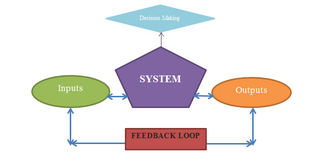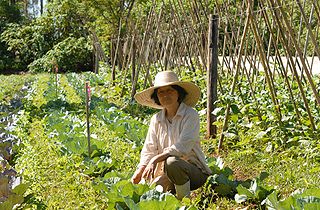The following outline is provided as an overview of and topical guide to agriculture:
The following outline is provided as an overview of and topical guide to sustainable agriculture:
Sustainable living describes a lifestyle that attempts to reduce an individual's or society's use of the Earth's natural resources, and one's personal resources. It is often called as "earth harmony living" or "net zero living". Its practitioners often attempt to reduce their ecological footprint by altering their methods of transportation, energy consumption, and/or diet. Its proponents aim to conduct their lives in ways that are consistent with sustainability, naturally balanced, and respectful of humanity's symbiotic relationship with the Earth's natural ecology. The practice and general philosophy of ecological living closely follows the overall principles of sustainable development.

Biochemical engineering, also known as bioprocess engineering, is a field of study with roots stemming from chemical engineering and biological engineering. It mainly deals with the design, construction, and advancement of unit processes that involve biological organisms or organic molecules and has various applications in areas of interest such as biofuels, food, pharmaceuticals, biotechnology, and water treatment processes. The role of a biochemical engineer is to take findings developed by biologists and chemists in a laboratory and translate that to a large-scale manufacturing process.
John Todd is a biologist working in the general field of ecological design. He addresses problems of food production and wastewater processing by using ecosystems technologies that incorporate plants, animals and bacteria. Todd has developed "Arks" or "bioshelters", ecologically closed "life-support systems" with the goal of sustainable functioning. He combines alternative technologies for renewable energy, organic farming, aquaculture, hydroponics and architecture to create "living machines" or "eco-machines".

Lodz University of Technology (TUL) was created in 1945 and has developed into one of the biggest technical universities in Poland. Originally located in an old factory building, today covering nearly 200,000 sq. meters in over 70 separate buildings, the majority of them situated in the main University area. Almost 15,000 students are currently studying at the University. The educational and scientific tasks of the University are carried out by about 3,000 staff members.

The Miguel Hernández University of Elche, is a Spanish Public University, open to the world, offering education, research and services facilitating the comprehensive development of its students. It is located in the province of Alicante and was established in 1996. Its name commemorates the Spanish poet Miguel Hernández.
Ecological engineering uses ecology and engineering to predict, design, construct or restore, and manage ecosystems that integrate "human society with its natural environment for the benefit of both".
Blackwater in a sanitation context denotes wastewater from toilets, which likely contains pathogens. Blackwater can contain feces, urine, water and toilet paper from flush toilets. Blackwater is distinguished from greywater, which comes from sinks, baths, washing machines, and other kitchen appliances apart from toilets. Greywater results from washing food, clothing, dishes, as well as from showering or bathing.

Sustainable architecture is architecture that seeks to minimize the negative environmental impact of buildings by efficiency and moderation in the use of materials, energy, development space and the ecosystem at large. Sustainable architecture uses a conscious approach to energy and ecological conservation in the design of the built environment.
Organic describes forms, methods and patterns found in living systems such as the organisation of cells, to populations, communities, and ecosystems.
The following outline is provided as an overview of and topical guide to ecology:

Jeonbuk National University is a national research university founded in 1947, located in Jeonju, South Korea. As the flagship national university for the Jeollabuk-do province, Jeonbuk National University has been ranked 501–550th in the world by QS Top Universities Ranking in 2016.

Regenerative design is a process-oriented whole systems approach to design. The term "regenerative" describes processes that restore, renew or revitalize their own sources of energy and materials. Regenerative design uses whole systems thinking to create resilient and equitable systems that integrate the needs of society with the integrity of nature.
Ecological design or ecodesign is an approach to designing products with special consideration for the environmental impacts of the product during its whole lifecycle. It was defined by Sim Van der Ryn and Stuart Cowan as "any form of design that minimizes environmentally destructive impacts by integrating itself with living processes." Ecological design is an integrative ecologically responsible design discipline. Ecological design can also be posited as the process within design and development of integration environmental consideration into product design and development with the aim of reducing environmental impacts of products through their life cycle.
This page is an index of sustainability articles.

The natural environment, commonly referred to simply as the environment, includes all living and non-living things occurring naturally on Earth.
Environmentally sustainable design is the philosophy of designing physical objects, the built environment, and services to comply with the principles of ecological sustainability.

A nutrient cycle is the movement and exchange of organic and inorganic matter back into the production of matter. Energy flow is a unidirectional and noncyclic pathway, whereas the movement of mineral nutrients is cyclic. Mineral cycles include the carbon cycle, sulfur cycle, nitrogen cycle, water cycle, phosphorus cycle, oxygen cycle, among others that continually recycle along with other mineral nutrients into productive ecological nutrition.
Sustainable products are those products that provide environmental, social and economic benefits while protecting public health and environment over their whole life cycle, from the extraction of raw materials until the final disposal.






